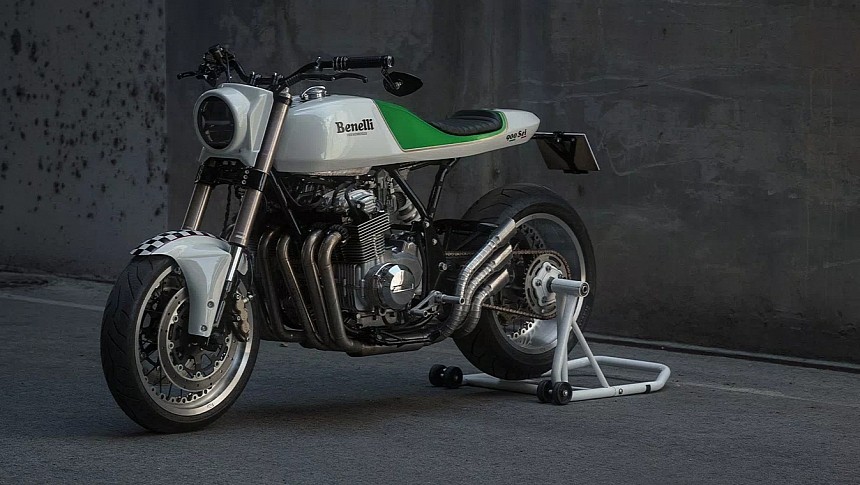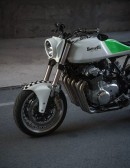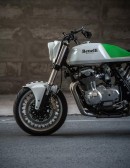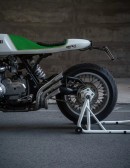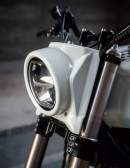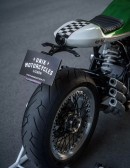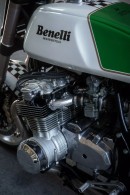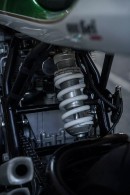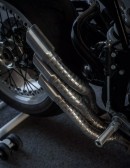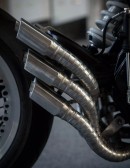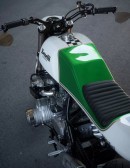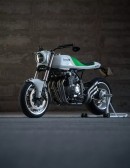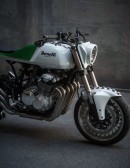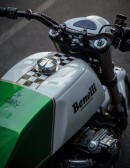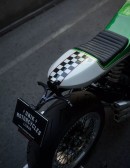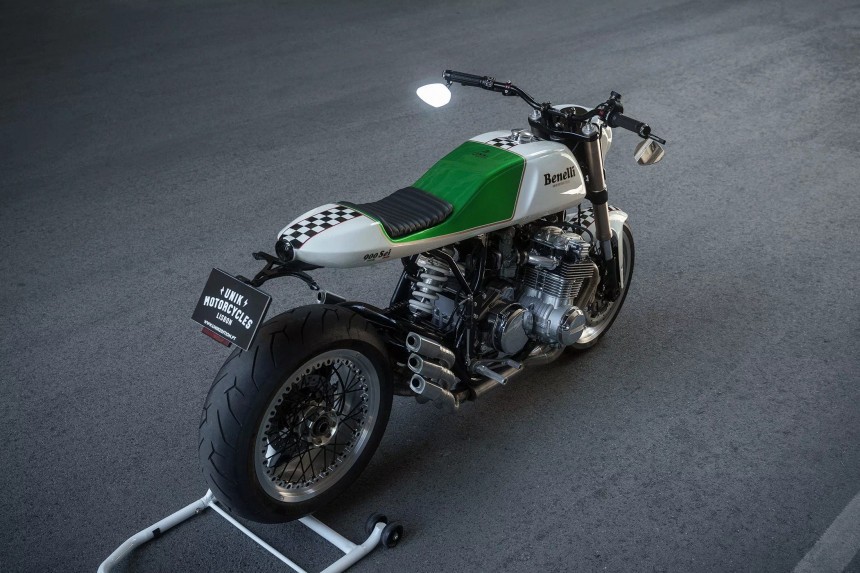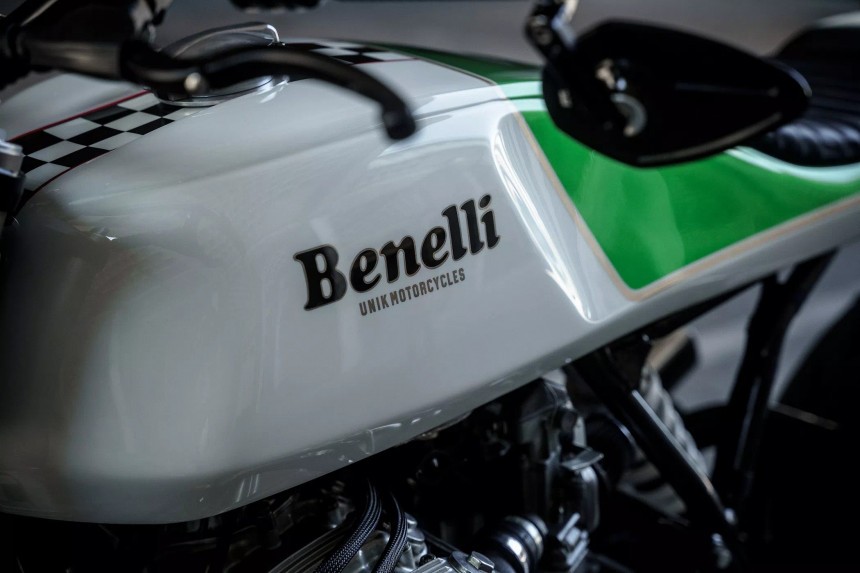When asked to think about a six-cylinder motorcycle, many people will immediately picture the imposing Honda CBX. Indeed, the Japanese titan is by far the most iconic production motorcycle to feature an inline-six engine configuration, but it wasn’t the first one to do so. Benelli had beaten Honda to the punch with the 750 Sei, which was teased in 1972 and put into production two years later.
The larger 900 Sei broke cover in ‘78, featuring a 906cc powerhouse with 9.5:1 compression, triple Dell’Orto carbs, and 80 hp on tap. Just like its 748cc predecessor, the updated Sei didn’t quite manage to achieve the commercial success Benelli would’ve hoped for, with fewer than 2,000 copies built before production ended in the late eighties. Nowadays, the Italian six-cylinder is fairly sought-after among collectors.
Its rarity may prevent most people from ever performing any irreversible modifications, but Luis Costa and Tiago Goncalves aren’t most people. They’re the skillful duo behind Unik Motorcycles over in Portugal, and this won’t be the first time we talk about their work here on autoevolution. Not long ago, we looked at the groovy Suzuki DR800S scrambler they nicknamed Big Suzy, so you might already know what these guys are capable of.
For the project we’ll be looking at today, their starting point was a stock 900 Sei from the model-year 1979. It calls itself Sinfonia following the Unik treatment, alluding to the incredible soundtrack sung by its inline-six mill and custom exhaust. We’ll get to the pipework a bit later on, though, because Tiago and his teammate kicked things off with a comprehensive overhaul of the engine’s internal workings.
The retro six-cylinder was freshened up wherever necessary, while its carburetors got rebuilt and subsequently topped with aftermarket pod filters. Next, Unik’s bike-modding connoisseurs moved on to the structural side of things, first replacing the original subframe with a bespoke alternative made from scratch. The machine’s main skeleton was also tweaked and reinforced in various places, but the stock swingarm got ditched altogether.
In its stead, you will now see the repurposed single-sided module of a Ducati Monster S4R. Linking this part to the Sei’s chassis was clearly no walk in the park, and the whole process involved the conversion to a monoshock suspension setup, as well. An adjustable aftermarket shock absorber connects to a tailor-made mounting point up top, yet there’s no rear fender to speak of.
Beefy upside-down forks are now tasked with handling suspension duties at the front, with custom triple clamps holding them in place. Down in the footwear department, we’re greeted by lightweight Kineo hoops clad in Pirelli Diablo Rosso tires. Additional stopping power is the product of floating brake discs and six-piston Tokico calipers up north, along with a drilled rotor at the back.
Turning their attention to the bike’s attire, Luis and Tiago deleted every piece of factory bodywork they could get their hands on. CAD software was then used to design a cafe racer-style monocoque outfit, which merges the fuel tank cover, seat pan, and tail section into a single unit. The mold has been 3D-printed, and the final part was shaped out of carbon fiber.
Hidden beneath it are a couple of handmade aluminum tanks, one for gas and the other for motor oil. The battery and a Motogadget control module live below the monocoque bodywork, too, both hooked up to a fresh wiring harness. Unik placed a thin solo seat right behind the tank cover, while integrating a circular LED taillight at the structure’s southernmost tip. In that same area, we notice a custom-built license plate bracket sporting tiny LED turn signals.
More bespoke garments are present at twelve o’clock, in the forms of a stylish headlight nacelle and an all-new fender with sport bike vibes. The headlamp itself is a premium LED component of aftermarket origin, joined by a digital Motogadget dial a bit further up. In the cockpit, there’s an LSL handlebar wearing compact switches and modern grips, as well as bar-end blinkers and mirrors.
Just like the instrumentation, all these accessories were sourced from Motogadget’s catalog, but a Domino throttle also makes an appearance. Sinfonia was really coming together nicely at this point, so the Unik duo only had two more tasks to complete before they could call it a day. The first of these saw Tiago and Luis fabricating a stainless-steel exhaust system, which runs a six-two-six layout and is said to sound absolutely incredible.
With the new pipework installed, it was time for the Portuguese specialists to take care of the motorcycle’s paint job. A glossy white base was applied to all the bodywork components, and it’s joined by a neat patch of green on the main monocoque part. Gold pinstripes, black Benelli graphics, and a checkered flag motif round out Sinfonia’s livery in style.
Its rarity may prevent most people from ever performing any irreversible modifications, but Luis Costa and Tiago Goncalves aren’t most people. They’re the skillful duo behind Unik Motorcycles over in Portugal, and this won’t be the first time we talk about their work here on autoevolution. Not long ago, we looked at the groovy Suzuki DR800S scrambler they nicknamed Big Suzy, so you might already know what these guys are capable of.
For the project we’ll be looking at today, their starting point was a stock 900 Sei from the model-year 1979. It calls itself Sinfonia following the Unik treatment, alluding to the incredible soundtrack sung by its inline-six mill and custom exhaust. We’ll get to the pipework a bit later on, though, because Tiago and his teammate kicked things off with a comprehensive overhaul of the engine’s internal workings.
The retro six-cylinder was freshened up wherever necessary, while its carburetors got rebuilt and subsequently topped with aftermarket pod filters. Next, Unik’s bike-modding connoisseurs moved on to the structural side of things, first replacing the original subframe with a bespoke alternative made from scratch. The machine’s main skeleton was also tweaked and reinforced in various places, but the stock swingarm got ditched altogether.
Beefy upside-down forks are now tasked with handling suspension duties at the front, with custom triple clamps holding them in place. Down in the footwear department, we’re greeted by lightweight Kineo hoops clad in Pirelli Diablo Rosso tires. Additional stopping power is the product of floating brake discs and six-piston Tokico calipers up north, along with a drilled rotor at the back.
Turning their attention to the bike’s attire, Luis and Tiago deleted every piece of factory bodywork they could get their hands on. CAD software was then used to design a cafe racer-style monocoque outfit, which merges the fuel tank cover, seat pan, and tail section into a single unit. The mold has been 3D-printed, and the final part was shaped out of carbon fiber.
More bespoke garments are present at twelve o’clock, in the forms of a stylish headlight nacelle and an all-new fender with sport bike vibes. The headlamp itself is a premium LED component of aftermarket origin, joined by a digital Motogadget dial a bit further up. In the cockpit, there’s an LSL handlebar wearing compact switches and modern grips, as well as bar-end blinkers and mirrors.
Just like the instrumentation, all these accessories were sourced from Motogadget’s catalog, but a Domino throttle also makes an appearance. Sinfonia was really coming together nicely at this point, so the Unik duo only had two more tasks to complete before they could call it a day. The first of these saw Tiago and Luis fabricating a stainless-steel exhaust system, which runs a six-two-six layout and is said to sound absolutely incredible.
With the new pipework installed, it was time for the Portuguese specialists to take care of the motorcycle’s paint job. A glossy white base was applied to all the bodywork components, and it’s joined by a neat patch of green on the main monocoque part. Gold pinstripes, black Benelli graphics, and a checkered flag motif round out Sinfonia’s livery in style.
